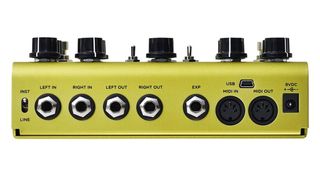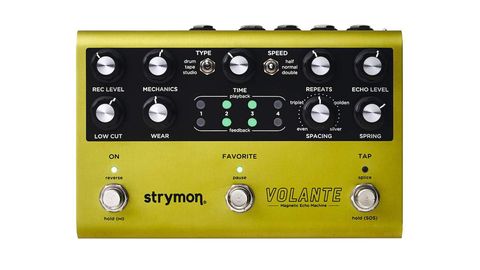The Italian-made Binson Echorec created its echoes using a rotating disc, also known as a platter or drum, which may have just inspired the name of Strymon’s new pedal that emulates it: disco volante means flying saucer in Italian.
Subtitled Magnetic Echo Machine, the Strymon Volante aims to not only recreate the sound of drum echo machines, as typified by the Echorec, but also offers the sound of tape echoes. The two options here are a multi-head Space Echo-style tape echo and a higher fidelity reel-to-reel machine, examples of which were often used to create echo in a studio setting. In the Volante, all three types benefit from four selectable playback heads, each of which can be set to full or half volume. You can also turn feedback on individually for each head and can even have a head’s feedback working if the head isn’t active. Adding to the sonic capability, you also get a spring reverb that can be mixed in with a single knob.
Sounds
The three different echo types each have their own distinct timbres, which really becomes apparent when you turn up the Rec Level knob, simulating driving the input of the real thing and getting a crunchier response that can make the repeats quite distorted at extreme settings. Further colouring is carried out with the Low Cut knob that naturally rolls off the bottom-end for thinner-sounding repeats, while the Wear control simulates the loss of high-end due to the degradation of the recording medium, producing softer, duller repeats. Another knob, Mechanics, also follows that route, taking each machine further away from tip-top condition and sounding just that little bit more wobbly with wow and flutter-style pitch modulation.
The Drum echo on the Volante is excellent, sounding convincingly like the real thing as used by David Gilmour. We were also able to dial in a pretty close match to some Hank Marvin echoes from the early 1960s when he was using a Meazzi Echomatic.
Unfortunately, we didn’t have a Binson or Meazzi on hand for direct comparison, but for the Tape mode we did have three Roland tape echoes: an RE-201, RE-301 and RE-501. While recreating the effect of using a single playback head is straightforward with these, it’s harder to replicate the signature multi-tap pattern created by the use of two or all three heads together, but the Volante is well up for the task. We were able to replicate the various combinations of the RE-201 Space Echo’s three playback heads with ease because it has equidistant heads.

By comparison, the other two machines have unevenly spaced playback heads, but that doesn’t create an issue because the Volante has a Spacing knob that effectively changes head spacings. Marked on the dial are Triplet, Silver ratio and Golden ratio settings, but the knob morphs continuously between them with real subtlety and it nails the RE-501’s head positions somewhere between eight and nine o’clock. The Studio setting gives a fuller sound and is great for unleashing your inner Elvis with some Sun Studio slapback.
So we’ve established it can emulate vintage machines without the bulk, noise and constant maintenance, but how about getting creative with that? Well, all straightforward delay tasks can be tackled with real attention to detail over the sound of the repeats, but there’s more: complex rhythmic repeat patterns, sheets of ambience hanging in the background, a sound-on-sound looper capability...
In fact, with all of the variation available, particularly the choice of heads/feedback and the spacing, there’s a wealth of stuff to explore here. This is an inspirational pedal, the sort that you could sit and play with for hours on end, enjoying taking your playing in new directions. Get to know what the knobs do and you’ll come up with some great variations that you’ll want to return to - which you can, as there’s onboard patch storage (eight from the front panel, 300 via MIDI). For performance, too, the expression input allows control of various parameters via an expression pedal. Alternatively, you can connect a footswitch for external tap tempo and other switching options.
This is a fantastic resource for vintage-style echoes, but it goes far beyond their original limits with the sheer range of adjustment available. The mechanisms and the sonics emulated here may be old-school, but the creativity engendered is bang up to date. Exceptional.

